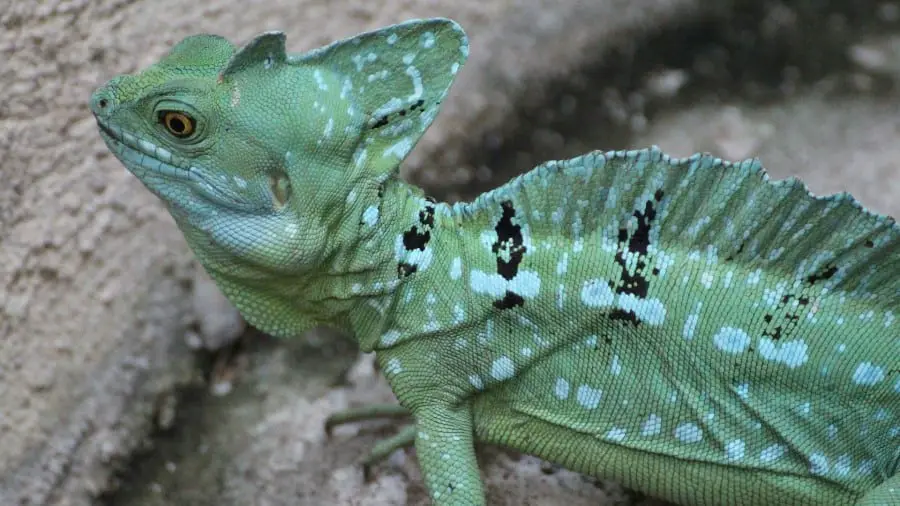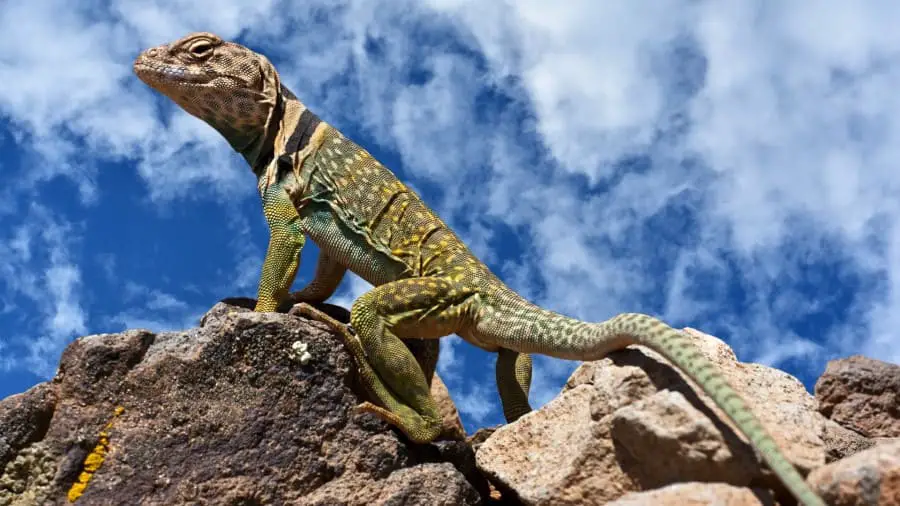
When you see iguanas run, they always seem to run on all fours. But, have you ever wondered if iguanas ever run just on their back legs alone? I know I have… so, I decided to look do some research myself, and here is what I’ve found. The answer is quite surprising.
There are only a few species of iguanas that do run on their back legs alone. Most iguanas can’t do that, they usually run on all four.
This might sound like an impossible task if you’ve ever seen an iguana. Most of them are huge in size. However, there are some species of iguanas that are smaller which allows them to balance running on only hind legs.
Iguanas That Run On Their Back Legs
From my research, I found that there are only 2 species of iguanas that run on their back legs. These iguanas are the helmeted iguanas and the collared lizards.
Helmeted Iguanas

The helmeted iguanas have a few different names. They are also commonly known as the basilisk lizard, helmeted basilisk, or casque-headed lizard.
I couldn’t find the exact speed of which the helmeted iguana runs at but I did find something mind-blowing about this iguana.
The helmeted iguana runs so fast that it can run above water! Hence the nickname “Jesus Christ Lizard” given by some people.
Check out the incredible video shot by National Geographic of a helmeted iguana run on water:
Collared Lizards

Collared lizards may not include “iguana” in their names but they are iguanas. The collared lizards can run surprisingly fast, clocking in at about 16 miles per hour. However, it’s still slower than the fastest species of iguanas (the spiny-tailed iguanas), clocking at about 21.5 miles per hour.
These iguanas can usually be identified by the 2 black bands around their necks. That is how they got their name.
Check out this video below to learn about these iguanas and see how they run, they are real cuties!
Balancing While Running With Back Legs
The helmeted iguana and the collared lizards both balance with their tails while they run. Without that, they couldn’t run like how they do.
Unlike most iguanas, the tails of helmeted iguanas and collared lizards don’t lose their tails easily. If they do, their tails will not regenerate like most other iguanas. Other than that, their weight and size also do help with their balance.
When Do These Iguanas Run?
These iguanas run when they are in danger or when a predator chases them. That’s their best defensive mechanism from predators. Both these species of iguanas are very small in size. There is no way they can fight off any predators if they are caught.
Helmeted iguanas are a little special though… they don’t run right away. Before they flea, they will play dead and if it works, great! But if that doesn’t fool the predator, they will start to run.
If these two species of iguanas are ever caught by predators on the tail, they are done for. Most other iguanas can just drop their tails as a defensive mechanism. This will either distract their predators or leave them with just a tail. Unfortunately, the helmeted iguanas and collared lizards can’t do that.
Why Don’t More Iguanas Run On Their Back Legs?
Most iguanas simply don’t have the technique or the right body types to run like the helmeted iguanas or collared lizards. Also, most iguanas have tails that drop way too easily. Without the tail, they just won’t be able to balance.
Common iguanas such as the green iguanas can grow up to 1.4 feet long from snout to vent (SVL) and around 3 to 4 kg in weight. On the other hand, the helmeted iguanas can only grow up to about 1 foot long (SVL) and weigh only about 200 g. Collared lizards are also of a similar stat in length and weight as the helmeted iguanas.
To show you a clear comparison, here’s a table that puts their stats side by side:
| Green Iguanas | Helmeted/Collared Iguanas | |
|---|---|---|
| Weight | 3 – 4 kg | 200 g |
| Length | 1.4 feet SVL | 1 foot SVL |
As you can see, there is a huge difference in the weight of these iguanas. For most iguanas, it makes sense to run on all fours because they can balance better since they are usually much bigger. On top of that, they also lose their tails way too easily.
Conclusion
Most iguanas don’t run on their back legs. In fact, only 2 species of iguanas run on their back legs and they are the helmeted iguanas and collared lizards.
These iguanas are able to run on their back legs by balancing themselves with their strong tails. Unlike many iguanas, these two species don’t lose their tails easily. So, their only choice to defend themselves is really just to run.
The most common reason why most iguanas don’t run just on their back legs is that they can’t. They are simply way too big and heavy to run like the helmeted iguanas and collared lizards.


